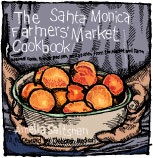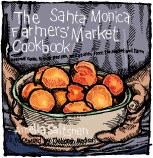
Recently, I spoke with accomplished author Amelia Saltsman, whose energy and passion was evident during our phone conversation. Check out the answers to some questions about her new book, The Santa Monica Farmers’ Market Cookbook. The Roadhouse will host Saltsman on June 26 @ 5:30pm. Check out our events page for more information.

What is your book about?
In a nutshell, great flavor, simple cooking, and the importance of supporting your local farmers.
Why did you write the book?
When was the last time you had a truly luscious strawberry or tomato, sweet-tart and juicy all the way through? Farmers’ markets are treasure troves of flavor, but shoppers are often overwhelmed by all the choices. My first goal is to remove the intimidation factor and help people discover how easy it is to find and use these fresh ingredients and enhance their busy lives through great flavor.
And, with all the talk today of locally grown, sustainable, and organic, I want to tell the stories of how our food is grown and show what it takes to get completely ripe ingredients to market within 24 hours of harvest. When we take the time get acquainted with the growers at our local markets, we gain a better sense of the need to be good stewards of the land.
Why a Santa Monica Farmers’ Market Cookbook? Is it only about Santa Monica?
The Santa Monica Farmers’ Market Cookbook certainly celebrates this extraordinary market and its farmers, but the bigger message is: Get to a farmers market and take advantage of the local ingredients you’ll find there. That’s the joy of farmers’ market shopping and cooking; you really get a sense of place. The recipes, cooking techniques, and shopping and storage tips are helpful no matter where you live or visit.
If you could use just one word to describe your book, what would it be?
Flavor. It all starts with taste. Everything we look for when we shop — good nutrition, easy cooking, sustainable growing practices, locally grown — falls into place when the raw ingredients taste great.
What kind of recipes will I find in the book?
There are more than 100 recipes in the book, and all of them showcase the natural flavors of each ingredient in the simplest ways possible. With just a few easy techniques, you can turn everyday ingredients into something absolutely delicious in no time at all.
The book contains everything from appetizers to desserts — because a great farmers’ market is so much more than an extra stop for just fruits and vegetables! You’ll find recipes like Short Ribs Braised in Red Wine, Nettle and Potato Frittata, and Pan-crisped Filet of Sole with Green Garlic Topping. And, if you’re a vegetarian or a vegan, you can make most of the recipes exactly as written, and many of the rest with tiny adjustments.
Where do the recipes come from?
These are the recipes I’ve developed over many years of cooking for my family and friends. They also stem from conversations with the farmers and chefs I meet at the market. Farmer Bill Coleman, for instance, taught me to use unripe green tomatoes in tart sauce for Black Cod with Green Tomatoes. Chef Suzanne Goin of Lucques and A.O.C. Restaurants shared her tip for turning nasturtiums into a peppery, colorful topping for fish, and Chris Kidder of Literati II gave me the idea for fresh Meyer lemon relish. These are the voices in the book: the chef, the farmer, and mine, the home cook.
Is the book suitable for beginners, or do I have to know how to cook to use it?
The book is perfect for novice and experienced cooks alike. Really, the only requirement is that you enjoy shopping for and using farm-fresh ingredients. There simply aren’t a lot of extra add-ins or fussing required when your basic ingredients have incredible flavor, variety, and freshness.
How is the book organized?
The book is organized by the traditional divisions of starters, soups, salads, and so on. But, within the chapters, each recipe is clearly labeled with the season(s) in which you are most likely to find its ingredients, and there’s a handy “Recipes by Season” appendix at the back of the book.
We’re so busy these days. Can it really be that simple to get dinner on the table?
The secret to getting dinner on the table quickly is to start with great tasting ingredients. When ingredients are at their peak level of freshness, it takes much less time and effort to assemble a delicious meal.
Why should I shop at a farmers’ market? Does it really make a difference?
Yes! There is a big difference when you purchase just-harvested, fully ripe produce. The farmer’s market offers ordinary foods with extraordinary flavors: strawberries, melons, potatoes, carrots, onions, tomatoes, green beans. To me, this is the most exciting part of shopping at the farmers’ market — everyday ingredients that really sing.
The farmers’ market also offers wonderful surprises people might not be used to seeing. In the summer, for instance, you might find green (young) chickpeas on the stalk or lamb’s quarters, an old-fashioned wild spinach that is delicious sautéed with sweet walla walla/maui type onions and folded into warm tortillas with a little crumbled queso fresco. Or exotic fruits, such as sapotes and cherimoyas, which are wonderful broiled with a little brown sugar and lime juice for dessert.
In terms of cost, how does farmers’ market produce compare with that offered by a local supermarket?
During the more than 20 years that I’ve been shopping at farmer’s markets around the country, I’ve found that farmers’ market produce is often half (or even less) the cost of that found at the supermarket! It’s local, it’s in season, and extra shipping and storage costs aren’t being passed on to the consumer. Value for dollar is also an important consideration.
Am I getting my money’s worth when I shop? Take summer fruits—plums, peaches, nectarines—if I have to discard a lot of my bargain purchase because it won’t ripen, I haven’t saved any money at all. It pays to be an aware shopper.
Not too long ago, an e coli outbreak forced stores to remove bagged spinach from their shelves. Talk a bit about the safety of food sold at the farmer’s market.
Farmers who grow for their own families and for direct selling often have a great sense of accountability in the field. It’s not anonymous and it’s not centralized — two of the greatest perils to responsible farming. Whether or not a farmer is certified organic, he or she is likely to use practices that far exceed the minimum criteria for organic. For most growers who choose this way of life, farming is a passion and they want to excel.
Can you give us a quick tip for shopping at the farmers’ market?
Use all your senses. Look at the colors, smell the aromas, feel for ripeness, taste the sweetness, and listen to the farmers — they know their crops well. They cook them at home for their own families, and they learn tips and tricks from all the chefs.
Many people opt for one major trip to the grocery each week. You, on the other hand, buy most of your food at the farmers’ market. How hard is it to cook well from the farmers’ market?
Not hard at all. In fact, I think it’s incredibly easy. Remember, a good farmers’ market can provide most of what you need — carefully raised or caught meat and fish, handcrafted cheeses, fresh eggs. What’s more, shopping at the farmer’s market can actually simplify your life, as fresh, ripe, seasonal foods require little technique and a minimal amount of pantry items or equipment.
Can you give us a few quick tips for finding flavor?
Here are my five easy steps to great flavor:
1. Buy the freshest, tastiest ingredients you can find, and you’ll be steps ahead.
2. Use simple cooking techniques that bring out flavor and texture, such as roasting, searing, and chopping.
3. Go for contrasting colors, flavors, textures, and temperatures.
4. Season your cooking in stages to add depth of flavor.
5. Keep it simple.
Diabetes, high cholesterol, heart disease. Americans are grappling with health concerns related to obesity and poor diet. Do farmers’ markets make a difference?
One of the greatest perks of shopping at the farmers’ market is that our cooking naturally tends toward lighter, healthier meals. Healthy cooking happens without even trying. When you want your main ingredient to shine, you’ll need less butter, oil, flour, sugar, etc. Desserts are a perfect example. That’s where you’ll really find that less is more: there’s simply no need to add loads of sugar to already sweet fruit.
How local is local?
If a farmer can drive produce to market for same-day sale, I consider that local. We have to be realistic, as many of us live in urban areas where farmland is more than a stone’s throw away. The important thing is to buy seasonally and locally whenever possible.
Can I really expect my child to embrace market meals?
I think so. Kids know what tastes good and will surprise us, if only we let them. The key is to offer variety. I have three grown children and a young granddaughter; everyone has had their likes and dislikes.
What’s with all the new-fangled foods — purple asparagus, artichokes, and potatoes, orange cauliflower and watermelons, white beets, baby broccoli?
Actually, these aren’t new inventions at all, but old varieties, many of which have been around for centuries. (Purple Peruvian potatoes, for instance, are directly descended from a 10,000 year-old spud!) Because small farms can grow a just row or two of different varieties of a crop, the farmers’ market system has given us a chance to get reacquainted with diversity in our foods.
How can I locate a farmers’ market in my area?
Do an internet search by typing in “farmers’ market” and your city or region. Many regions or states have umbrella organizations listing local markets. Just make sure that what you find is really a growers’ market. Key clues are words like certified, organic, and locally grown. If the main selling points are pony rides and caramel corn, you haven’t found the best of the best.
